-

新人教版高中英语必修2Unit 4 History and Traditions-Listening&Speaking&Talking教案一
This unit is about history and traditions. From the opening page, we can know that this unit will introduce the history and traditions around the world. As Marcus Garvey says “A people without the knowledge of their past history, origin and culture is like a tree without roots”, it is important for students to realize the importance and value of knowing the history and traditions and their further meanings. And this part ( listening and speaking ) is divided into two parts: Part A---share views on historic sites, Part B ---talk about a visit to a historic tourist destination. By talking with a foreigner, the speakers introduce the historic attractions and their cultures. Part A is that William, a British student, who was going to visit the Confucius Temple and a Chinese student, Xiao Kong, who was going to the Confucius Temple to meet with the members of the research group, went together and exchanged their views on the Confucius Temple, Confucius, Confucius' descendants and Confucius' educational thoughts. Part B is a conversation between Xiao Yan, a youth hostel receptionist and Paul, a backpacker about the feelings and experience after visiting the Chinese famous tourist attraction Pingyao.1. Guide students to understand the content of listening texts in terms of the whole and key details; 2. Cultivate students' ability to guess the meaning of words in listening; discuss with their peers how to talk about historic spots and great person.3. Instruct students to use functional sentences of showing one’s excitement, surprise and disappointment.1. Guide students to understand the content of listening texts in terms of the whole and key details; 2. Cultivate students' ability to discuss with their peers the related topics.3. Enable students to use the functional items of showing one’s excitement, surprise and disappointment.

新人教版高中英语必修2Unit 3 The Internet-Reading For Writing教案一
⑦identity theft 身份盗窃⑧chat room 聊天室⑨draft your blog post 起草博客帖子⑩post embarrassing photos 张贴尴尬照片 【话题句式】 1. How do you stay safe online and avoid bad experiences on the Internet? 你如何在网上保持安全, 避免在网上的不良经历? 2. I’m not an expert, but many years as a blogger have taught me a thing or two. 我不是专家, 但作为一个博主, 我已经学了好几年了。 3. If you see or read something that makes you feel uncomfortable, leave the site immediately. 如果你看到或读到一些让你觉得不舒服的东西, 立即离开这个网站。4. Don’t give out your address or phone number. 别告诉别人你的地址或电话号码。 5. Identity theft is a common and serious problem. 身份盗窃是一个常见而严重的问题。6. Being online is no excuse for being rude, and you don’t want to become a target for a troll or cyberbully. 上网并不是无礼的借口, 你也不想成为发挑衅帖子的人或网络恶霸的目标。 7. Trolls often use several false names so that they can stay on a site. 发挑衅帖子的人经常使用几个假名, 这样他们就可以留在一个网站上。8. However, the more polite you are, the less likely it is you will be attacked. 然而, 你越有礼貌, 你被攻击的可能性就越小。

新人教版高中英语必修2Unit 4 History and Traditions-Reading and Thinking教案一
Features of languages1.Finally, in the 20th century, the southern part of Ireland broke away from the UK, which resulted in the full name we have today: the United Kingdom of Great Britain and Northern Ireland.该句是一个复合句。该句主句为:the southern part of Ireland broke away from the UK;which resulted in the full name we have today为which引导的定语从句代指前面整句话的内容,we have today为定语从句修饰先行词name。译文:最后,在20世纪,爱尔兰南部脱离英国,这导致了我们今天有的英国的全名:大不列颠及北爱尔兰联合王国。2.Almost everywhere you go in the UK, you will be surrounded by evidence of four different groups of people who took over at different times throughout history.该句是一个复合句。该句主句为:you will be surrounded by evidence of four different groups of people;其中Almost everywhere you go in the UK为让步状语从句; who took over at different times throughout history为定语从句修饰先行词people。译文:几乎无论你走到英国的任何地方,你都会发现历史上有四种不同的人在不同的时期统治过英国。3.The capital city London is a great place to start, as it is an ancient port city that has a history dating all the way back to Roman times.该句是一个复合句。该句主句为:The capital city London is a great place to start; as it is an ancient port city that has a history dating all the way back to Roman times.为原因状语从句;dating all the way back to Roman times为现在分词短语作定语修饰history。

新人教版高中英语必修2Unit 4 History and traditions教案
这个地区有着深厚的传统。既学既练:为了让更多的外国游客了解中国文化,欣赏中国美丽的自然风光,感受中国发生的巨大变化,某外文杂志社将出版一本英语小册子来介绍中国的旅游景点。该杂志社邀请你为该小册子写一篇英语短文来介绍杭州,内容包括:1.杭州的位置(中国东南部)、面积(16 000多平方公里)及历史(2 200多年)等;2.杭州的旅游特色(自然风景、传统文化、特色小吃等);3.希望更多的游客来杭州参观。注意:1.词数80左右;2.可适当增加细节,以使行文连贯。Located in the southeast of China, Hangzhou is a beautiful city.Dating back more than 2,200 years, Hangzhou covers an area of more than 16,000 square kilometers.In Hangzhou, you can visit the West Lake, whose scenery is fascinating.In addition, you can’t miss its cultural relics and historical sites, from which you will learn more about excellent Chinese traditional culture and traditions.In Hangzhou, the special snacks are famous and visitors from different parts of the world think highly of them.As a tourist attraction, Hangzhou attracts a large number of visitors from home and abroad every year.Once you come to China, Hangzhou is a scenic spot you can’t miss.

新人教版高中英语必修2Unit 5 Music-Listening and Speaking教案
This lesson is about music. Students can classify the types of music through the instruments and its sound and can talk about their preferences about music, even join some activities and play a role in them according to their musical talents. On the basis, they are guided to use the languages to express their preferences and some plosive sounds and their rules.1. Classify the music types through the instruments and its sound.2. Listen and understand what the speakers’ preferences are and the reasons; talk about their own preferences and give their own reasons, using these sentences: “What kind of music do you like? And why? “ “Because it makes/gives me energy/peaceful.../touches my heart...”.3. Learn some plosives and the rules.4. Join some activities and play a role in them according to the talents. 1. Listen and understand what the speakers’ preferences are and the reasons;2. talk about their own preferences and give their own reasons, using these sentences: “What kind of music do you like? And why? “ “Because it makes/gives me energy/peaceful.../touches my heart...”.3. Learn some plosives and incomplete plosives and its rules.Step 1 Lead inPoint at the pictures on P50 and ask Q1: What are the people doing in the pictures below?Q2: What kind of music they are?Then play the MP3s one by oneStep 2 ListeningTask 1: A reporter from the school newspaper is interviewing students about music. Listen to the interviews. Draw lines between the words to make complete sentences. Some words will not be used.
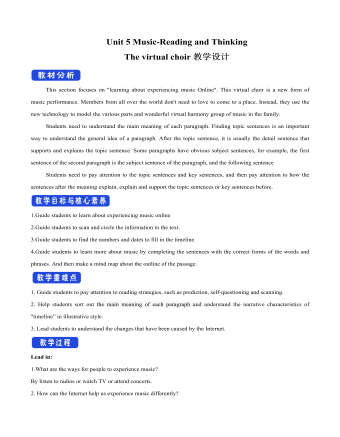
新人教版高中英语必修2Unit 5 Music-Reading and Thinking教案一
This section focuses on "learning about experiencing music Online". This virtual choir is a new form of music performance. Members from all over the world don't need to love to come to a place. Instead, they use the new technology to model the various parts and wonderful virtual harmony group of music in the family. Students need to understand the main meaning of each paragraph. Finding topic sentences is an important way to understand the general idea of a paragraph. After the topic sentence, it is usually the detail sentence that supports and explains the topic sentence. Some paragraphs have obvious subject sentences, for example, the first sentence of the second paragraph is the subject sentence of the paragraph, and the following sentenceStudents need to pay attention to the topic sentences and key sentences, and then pay attention to how the sentences after the meaning explain, explain and support the topic sentences or key sentences before.1.Guide students to learn about experiencing music online2.Guide students to scan and circle the information in the text.3.Guide students to find the numbers and dates to fill in the timeline.4.Guide students to learn more about music by completing the sentences with the correct forms of the words and phrases. And then make a mind map about the outline of the passage.1. Guide students to pay attention to reading strategies, such as prediction, self-questioning and scanning.2. Help students sort out the main meaning of each paragraph and understand the narrative characteristics of "timeline” in illustrative style.3. Lead students to understand the changes that have been caused by the Internet.

新人教版高中英语选修1Unit 3 Fascinating Parks教案
2. Explore the significance of the establishment of Sarek National Park.Q1: Which event is the most important one in the park’s history?Ss: The establishment of Sarek national park in 1909 is the most important one.Q2: Is it worth making a place like Sarek a national park? Give your reasons.Ss: Yes. In this way, the place can be kept in its natural state and natural beauties and other rare and valuable resources can be preserved instead of being destroyed by endless exploitation driven by profits.Q3: How does the writer organize his introduction to the history of Sarek?Ss: The writer organizes his introduction in the sequence of time, using time indicators such as “used to”, “around 9,000 years ago”, “soon after”, “following the reindeer”, and “in 1909”.Q4: What is the feature of the language used to introduce the history of the park?Ss: The introduction to the park is to provide facts, using time indicators to organize the events. Sentences starts with “third person” and passive voice is used more often, feeling objective.【设计意图】学生寻找和梳理公园历史上的重要事件,体会人与自然的和谐关系,评鉴介绍性语言的特点。【核心素养提升点】发展自主提取、梳理文本信息能力,训练逻辑思维和高阶思维。Activity 3: Highlighting the secret of the text
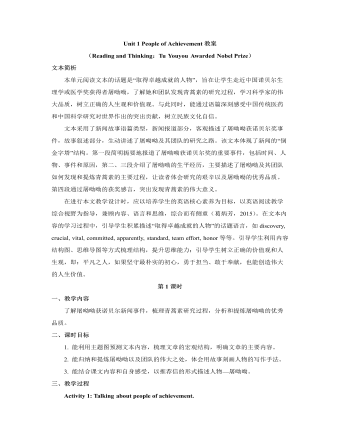
新人教版高中英语选修1Unit 1 People of Achievement教案
【设计意图】 基于上述分析,学生总结新闻故事语篇类型的特征,即标题的省略性、导语的概括性、数据的支撑性和引语的重要性。在此过程中,学生对新闻故事语篇类型有了更深层次的了解,对于学生阅读和写作具有重要意义。Activity 7: Discussing to make a writing outline.本活动为实现课时目标3。1.Discuss and make an outline.Ask students to discuss in groups of four and make their own writing outline.To celebrate the 70th anniversary of the People’s Republic of China, our school newspaper starts a new column about “People of Achievement”. You plan to write a news story about one of the winners of the Medal of the Republic in 2019, including Yu Min, Shen Jilan, Sun Jiadong, Li Yannian, Zhang Fuqing, Yuan Longping, Huang Xuhua and Tu Youyou.【设计意图】 教师创设情境,即为庆祝新中国成立70周年,校报新增有关卓有成就人物的栏目,你将从共和国勋章获得者中,选择一位写一篇新闻故事,向该栏目投稿。学生以小组合作形式,展开讨论,并写出新闻故事框架,有助于学生课后收集人物信息,撰写新闻故事。
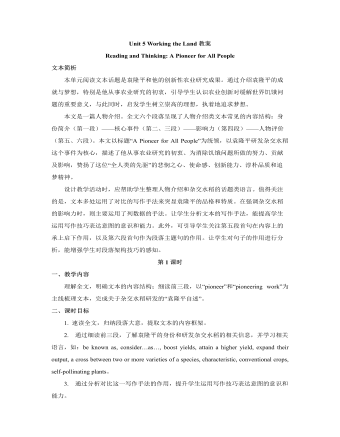
新人教版高中英语选修1Unit 5 Working the Land教案
1. 完成文本主要信息填空(斜体字部分设空):As a witness to farmers’ poor harvests and even a severe shortage of food, Yuan Longping was determined to devote his life to tackling this crisis. After graduation, he realized that what farmers needed most was to boost yields in the fields. Yuan was convinced that the answer lay in the creation of hybrid rice, one characteristic of which is that it usually achieve higher output than conventional crops. However, it was no easy job. The first difficulty he needed to overcome was scientists’ general assumption that this could not be done. Through trial and error, Yuan managed to generate this incredible crop. It is estimated that about 60 percent of domestic rice consumption in China was comprised of crops generated from Yuan’s hybrid strains. His innovation has enabled Chinese farmers to considerably expand their output and helped feed the world. Unwilling to retire early to a life of leisure and unconcerned about celebrity or fortune, Yuan continues to turn one vision after another into realities.2. 模仿写作:Do some research via the Internet and introduce another agricultural scientist, Chen Risheng(陈日胜), using the structure, expressions and writing techniques you have learnt from the text “A Pioneer for All People”.【设计意图】任务1是对文本内容和词汇学习成效的检测。任务2借助文本中学到的词汇和写作手法仿写另一位科学家,提升学生迁移运用词汇、文体结构和写作方法的能力。

新人教版高中英语选修4Unit 1 Science Fiction教案
本活动旨在落实课时教学目标2。 1.Think, discuss and share. Students form groups of 4, discuss about the given ending make comments. Q1: Do you like the ending? Q2: Was it a logical ending? Why so or why not? [设计意图]通过引导学生思考、讨论、评价,比较个人、同伴所预测的结局和听力文本所给定的结局的异同点,深化对文本的认知,发展学生的评判性思维能力。 Activity 4: Exploring Asimov’s three laws of robotics and the purpose of the writing 本活动旨在落实课时教学目标3。 1. Get to know Isaac Asimov’s three laws of robotics. The teacher shares Isaac Asimov’s three laws of robotics. The three laws state that: ①A robot may not injure a human being or, through inaction, allow a human being to come to harm. ②A robot must obey any orders given to it by human beings, except where such orders would conflict with the First Law. ③A robot must protect its own existence as long as such protection does not conflict with the First or Second Law. Q: How does Tony’s story relate to the laws? 2. Figure out Isaac Asimov’s purpose of writing Satisfaction Guaranteed. The students express their opinions about the author’s writing purpose. Q: Why did Isaac Asimov write such a story? S: To explore the relationship between robots and humans. [设计意图]通过了解艾萨克·阿西莫夫所制定的机器人三大定律,加深学生对文本的理解,深入探究文本的主题意义。推理作者的写作目的,联系生活实际,思考人类与机器人的关系。

新人教版高中英语选修4Unit 2 Iconic Attractions教案
帮助学生通过讨论与对主题的提升,反思自己的旅游方式,以便做出更优化的安排,在今后的旅程中有更多的收益。 Activity 2: Further discussion of the 6 elements above and supplement of more background knowledge 本活动为实现课时教学目标2。 1.Target Q: The writer’s clear target of traveling, meeting the people and experiencing the culture, is closely related to his major in social studies. Then what is social studies? Social studies is a part of a school or college curriculum concerned with the study of social relationships and the functioning of society and usually made up of courses in history, government, economics, civics, sociology, geography, and anthropology. (Dictionary by Merriam-Webster) Reflection: When you go out to travel, what targets do you usually have in mind? 2.Research Q: Suppose you are traveling to Hangzhou during the school holidays, how will you do research on the city? (surf the internet, read books or travel brochures, consult friends, ...) What information will you be interested to know? (location, iconic sites, local cuisines, interesting customs, shopping malls ...) 3.Abandonment To make the most of time, we have to learn to abandon so that we can accomplish our plan. What will you be interested in doing if you go to Hangzhou if you have a week’s time? What if you only have 2 days? 4~5. Venturing & Experiencing Q: What did he venture to do during the trip? What new experiences did he have? In Sydney: attend his first open-air barbecue, enjoy many different but yummy meals In Catherine: observe the life and customs of the aborigines appreciate their music & try the musical instruments: the didgeridoo
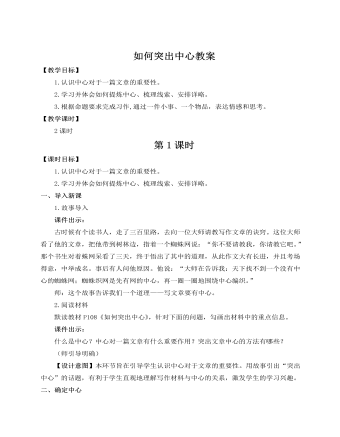
人教部编版七年级语文上册如何突出中心教案
我们一家乘车行驶在黄土高原上,眺望远处云朵,尽情享受着清风的洗礼……因为我们要回老家喽!倘若乖乖地欣赏美景,是坐不住的。虽说有起伏不定的高原,波涛汹涌的黄河,不时从石缝里“蹦”出来的水丝帘,一望澄澈的蓝天,悠然飘过的白云……可当这一切的美景同时“刷”在你的眼前,且接连不断地出现时,还是会让你感到几分乏味。因为,这可是八小时的长途跋涉啊!每到这时候,车里的人们就疯狂了起来。虽说只有区区四人,可还是组成了一个超级合唱团。不信你看爸爸已经兴奋起来。只见他清清嗓子,扭动身子,接着便“肆无忌惮”地高声唱起来。妈妈则是一副欲唱又止的样子,最终也只是淡淡地笑了笑。在这一刹那,妈妈神情是最复杂也是最可爱的。是快乐还是骄傲?是幸福还是羞涩?总之,略有些放不开。后来,她也开始有节奏地在车门上敲击,敲出一串美妙又兴奋的声音。好像她所有的快乐都被谱成了一首无拘无束的歌。
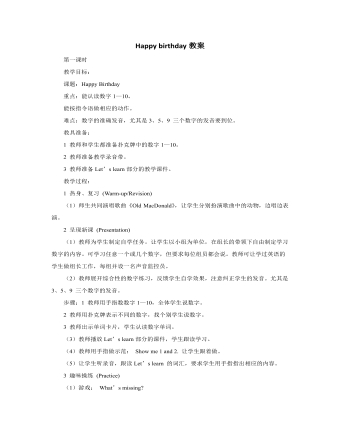
人教版新课标PEP小学英语三年级上册Happy birthday教案
(2)猜猜看每次请一个同学在黑板上画一种刚学到的物品,他每画一笔,就请班上的同学用英语猜他画的是什么。如猜得正确,就请下一位同学再重新开始画另一种物品。(3)Let’s rhyme.将所学的单词替换第一单元的Let’s chant中的文具。教师将全班分为两大组,教师举图片提示,如第一组说:I have a balloon.第二组一起说:Me too. 拍手,举第二幅图时两组交换。以此类推。(4)教师将单词的图片先面朝上贴在黑板上,给学生20秒时间记住这些单词,然后每张图卡用1张彩色纸盖上。学生要先说出彩色纸的颜色,再说出下面卡上的词。待学生熟悉后,可加大游戏难度,将盖着彩色纸的图卡在(黑板上)打乱,进行游戏。(5)让学生听录音,边说边做Let’s do部分的活动。(6)教师将Let’s do中的图卡打乱顺序,贴在黑板上,教师说一个指令,请学生指出正确的图片。正确的可为本组赢一分。

人教版新课标PEP小学英语三年级上册Hello!教案4篇
(3)通过游戏Simon says 来练习以show, open, close, put, carry 所引导的祈使句。教师发指令学生做动作。但只有听到老师带有Simon says的指令时,才能做出相应的动作,否则就是失败。失败的同学退出游戏。(4)听Let's chant的录音,学生边听边做,逐渐过渡成边听边说边做,最后独立说做,并进行比赛。4. 课堂评价(Assessment)做活动手册本单元第5部分练习。学生根据录音,圈出所听到的文具。具体方法和步骤参考如下:(1)学生看图,用英语说出图中每样文具物品。(2)教师讲解题目的意思并指导做的方法。(3)学生听录音做练习。(4)再放录音,在教师的指导下让学生一句一句地跟读并互相核对答案,并说出所圈的文具,再通过给花朵涂色进行自我评价。5. 扩展性活动(Extensive activities)选词游戏。将学生分为六组,每组各派一个选手,教师说单词,选手快步跑到讲台前,找到所说单词,并举起大声读出,正确为胜。
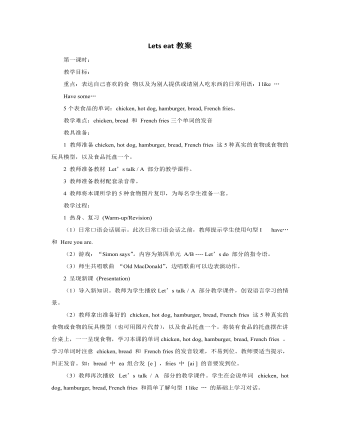
人教版新课标PEP小学英语三年级上册Lets eat教案
教师将本课A、B部分所学单词的图片卡贴在黑板上,找两个学生各手持一把新苍蝇拍,教师读出一个单词,学生就要马上找出来并拍立一下。第一个拍的学生获胜。(4)教师准备一个小场景:将所有学过的食品及饮料或模型放在一个铺着台布的桌上,请学生根据A、B部分的Let’s talk进行自由会话。2.新课展示(Presentation)(1)本课时Let’ s learn中的单词认读教学,可继续采用A部分第二课时的教学方法,利用课件,让学生利用已掌握的拼读规则,认读和学习新单词。(2)让学生听Let’s learn的录音,一边听,一边指着书上相应的图,力求做到“眼到,手到,口到,心到”。(3)用一组连贯的动作教Let’s do中的动词Pour,smell,taste,drink。首先,教师左手端着一个茶壶,右手拿一茶杯,对全班说:Look!I’m pouring the tea. Pour the tea.(边倒茶,边说两遍)。
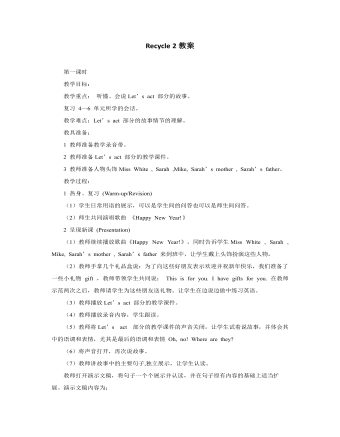
人教版新课标PEP小学英语三年级上册Recycle 2教案
3 趣味操练 (Practice)(1)请学生拿出他们事先准备的材料,指导学生按步骤进行摇摇乐的制作,每句话中的第一个动作都是教师要强调的部分,一定要配合手势,帮助学生理解和记忆。教师可适当给学生充分的时间,让学生用颜色笔将摇摇乐画得更漂亮些,有条件的话,可以用相机将学生的作品拍下来,有机会可以展览。(2)让学生跟着录音一起唱歌曲 Happy New Year,可以在唱歌时打节拍或边唱边舞。4 课堂评价 (Assessment) 做活动手册本单元4、5 部分的练习。本次评价要与课本上的4—6单元评价相结合,让学生自己动手填写评价表,评价自己。5 扩展性活动(Add-activities)新年的时候将歌曲 Happy New Year唱给爷爷奶奶,爸爸妈妈听,祝贺他们新年快乐!板书设计:Recycle 2Let’s make 部分的制作流程图Happy New Year! (一月一日的日历)
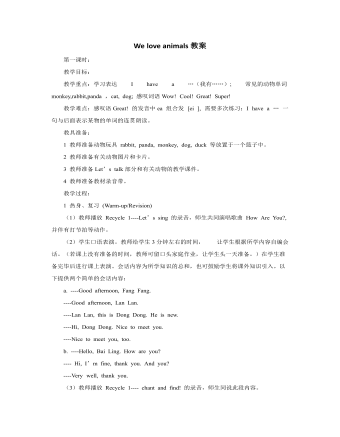
人教版新课标PEP小学英语三年级上册We love animals教案
(1)游戏:向它那儿跑去(Run to it!)首先,用图片和词卡练习本课的6个新单词。学生边读老师边把卡片贴在黑板上。将全班分成两队。给学生下一个Run to the bird.这样的指令。每队的第一个学生向带有鸟的图卡和词卡的地方跑,并且用手摸一下这两张卡片。哪组学生先摸到卡片就给他们队得一分。教师也可以用本课刚学的指令:Walk to….Jump to ….Fly to….等指令学生用相同的动作走(跳,飞)到卡片前。(2)教师将Let’s do的图片打乱顺序,让学生听指令,选出正确的图片。(3)游戏:照我说的做(Do as I say)教师发指令,全班同学起立做动作。做错的同学随时坐下。最后,哪组站着的同学多,哪组获胜。教师参考指令: Climb like a monkey/bear.Jump like a squirrel/rabbit.Walk like an elephant/duck.Hunt like a mouse/pig.Act like a cat/dog.Fly like a bird.为了增加游戏的难度和趣味性,教师可逐渐加快指令的速度。4.课堂评价(Assessment)做活动手册本单元第5部分的练习。方法和步骤参考第一单元。
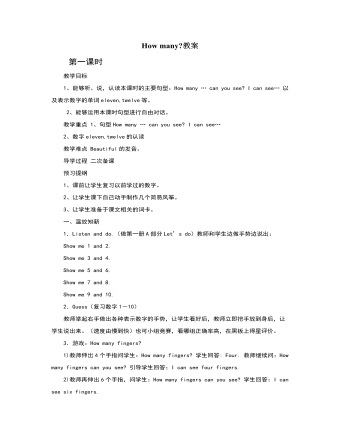
人教版新课标PEP小学英语三年级下册How many教案
一.温故知新1.教师播放“One, two, three, four, five”歌曲的录音带,让学生跟随录音一起唱。2.复习数字1-151)报数:教师让学生从1-15按顺序用英文报数,如果前一个学生报到15了,那么下一个学生就要从1再开始。2)游戏:叫号。教师把写有one —fifteen的单词卡发给学生,教师随意说数字,谁拿着相应的单词卡,谁就站起来并大声读出该单词。3.操练句型How many … can you see? I can see…和How many… do you have? I have…(使用15以内的数字)二.新课呈现 1.教师将1-15的数字卡贴在黑板上,用其中的两张组成一个算式,在两张数字卡的中间写上“+”号,其和为15以内,让学生去计算,如Ten and five is fifteen.2.让学生两人一组,一个学生摆算式,另一个学生用英文说出结果。3.教师出示算式卡,如Nine and seven,让学生快速说出两数之和,并请最先说出答案的学生将算式用数字形式写在黑板上,在单词卡中找到相应的单词贴在和的位置上。
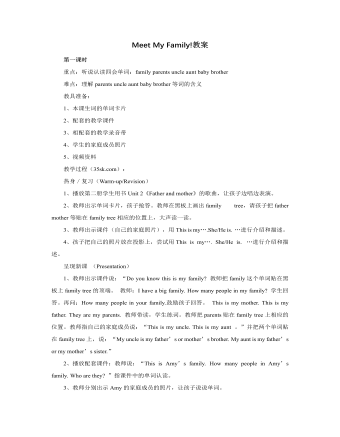
人教版新课标PEP小学英语四年级上册Meet My Family!教案
教案点评: 本课时在上一课时的基础上,进一步在情景中学习句型Is this your...? He/She looks... What’s he/she? They look... Are they...? 本课时的内容和学生的实际生活贴近,学生对该话题感到亲切,教学新句型时教师运用学生的家庭照片,在师生的对话中自然的呈现新知和操练句型,有助于学生更好的掌握和操练对话。本堂课教学层次分明,教师引导适当,发挥了学生在学习中的主体地位第六课时重点:单词nurse, doctor, farmer, driver的拼写。难点:I’m going to be a…教具准备:1.图片nurse, doctor, farmer, driver2.教材相配套的教学录音带3.单词卡片教学过程(35sk.com):一 热身/复习(Warm-up/Revision)1.口语练习:How many people are there in your family?Who are they?What are they?2.让学生改编B部分的chant, 然后表演出来。教师对表现出色的应即使给予奖励。二 呈现新课 (Presentation)1.教师出示表示表职业的单词卡让学生认读,并贴在黑板上。2.做找朋友的游戏。让学生把图片贴到相应的单词下。
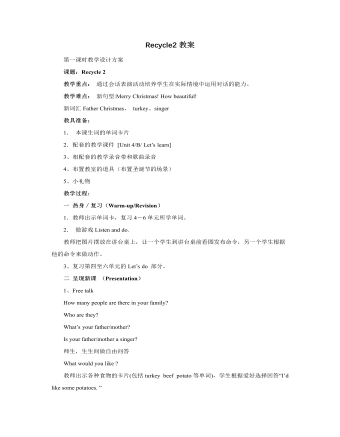
人教版新课标PEP小学英语四年级上册Recycle2教案
二 呈现新课 (Presentation) 1、pass the word 两个小组听音乐同时向后传词卡,一组传成员,一组传职业。音乐停后,拿成员的学生问另一人,如:“What’s your father? My father is a doctor.” 2、group work 两人一小组,互问答,学生根据对方的回答摆词卡。 根据卡片,用句子描述一下自己的家庭成员和职业。(仿照歌谣中的句型) 3、Listen and match 听一听Chant,请孩子们根据录音摆一摆卡片。一个学生在黑板上摆。 4、观看课件,边看边跟读。看书,边看边指书中的人物。 5、听录音,边听边打节奏。男女生接龙说歌谣。各小组接龙说歌谣。请几个学生接龙说歌谣。6、各小组说一说,演一演歌谣。各小组展示歌谣。 7、教师出示一个制作好的圣诞礼物,说:“Do you like it?”“Today let’s make a gift ,ok?”教师边说边示范制作过程。学生认真听,理解。


